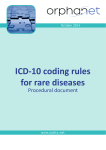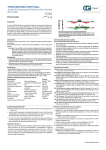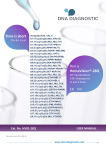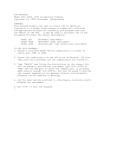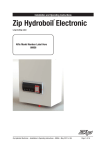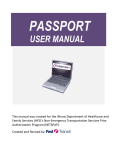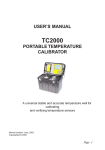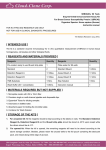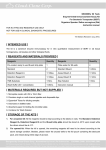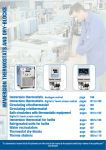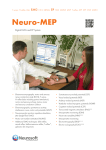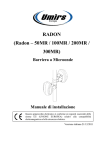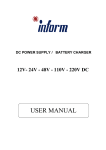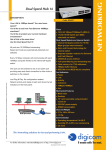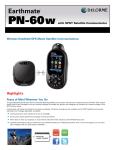Download "user manual"
Transcript
C/Agustín Escardino, 9 Parque Científico-Universidad de Valencia 46980 Paterna (Valencia) Tel:+34 963 212 340 www.imegen.es Nº ES063227-1 User manual ® imegen SCAs kit SCA1, SCA2, SCA3, SCA6 and SCA7 expansions detection by PCR and TP-PCR Reference: IMG-152 Made in Spain C/Agustín Escardino, 9 Parque Científico-Universidad de Valencia 46980 Paterna (Valencia) Tel:+34 963 212 340 www.imegen.es IMG-152 Nº ES063227-1 The information in this guide is subject to change without notice. Imegen guarantees that its products are free from defects, both in used materials as in its manufacturing process. This warranty is extended to the expiration date, as long as the storage conditions specified in this manual are met. Our products are designed for use in research. The user of the product is responsible for validating the usefulness of the protocol proposed by Imegen. These protocols are considered a guide only. Imegen does not offer any other warranty, express or implied, which extend beyond the proper functioning of the components of this set. Imegen sole obligation in respect of the preceding guarantees, will be to replace the product or return the purchase price thereof, as desired by the customer, as long as the existence of a defect in the materials test, or in the manufacture of its products. Imegen will not be responsible for any damage, direct or indirect, resulting in economic losses or damages resulting from the use of this product by the purchaser or user. All products sold by the Imegen are subjected to rigorous quality control. The imegen® SCAs kit has passed all internal validation tests, ensuring the reliability and reproducibility of each assay. For any questions about the applications of this product or its protocols, please contact our Technical Department: Phone number: 963 212 340 e-Mail: Rev.1.0 [email protected] 2/11 C/Agustín Escardino, 9 Parque Científico-Universidad de Valencia 46980 Paterna (Valencia) Tel:+34 963 212 340 www.imegen.es IMG-152 Nº ES063227-1 Index Kit description……………………………….….…………………………….. 4 Product description…………………………………..….……………………………………. 4 Content and storage of the kit………….……………..………………………………… 4 Amplification by PCR and TP-PCR…………………….…….………. 6 Equipment and material required....………..…………………………………………. 6 PCR reactions preparation……………………..…………..……………………………… 6 PCR amplification program………………………………………..……………………… 8 Fragment analysis………….…..…….………........…….…….…..……….. 9 Fragment analysis preparation…..…………..…………..……………………………… 9 Capillary electrophoresis…..………………………………………..……………………… 9 Rev.1.0 Results analysis……………………..…….………........…….…....……….. 10 3/11 C/Agustín Escardino, 9 Parque Científico-Universidad de Valencia 46980 Paterna (Valencia) Tel:+34 963 212 340 www.imegen.es Nº ES063227-1 IMG-152 1 Kit description Product description Spinocerebellar ataxias neurodegenerative (SCAs) diseases comprise a characterized heterogeneous primarily by group progressive of gait disturbance and to present a pattern of autosomal dominant inheritance. Different genes have been described in this pathology which mutation usually consists in the CAG repetition expansion. ® Imegen SCAs kit allows the CAG expansion analysis of the SCA1, SCA2, SCA3, SCA6 and SCA7 by PCR and TP-PCR. Repetitions Number (CAG)n* Gen SCA1 (MIM#164400) SCA2 (MIM#183090) SCA3 (MIM#109150) SCA6 (MIM#183086) SCA7 (MIM#164500) Chromosome location Normal Uncertain Allele Allele Reduced Expanded penentrance Allele. Allele Pathological ATXN1 6p22.3 6-39 - - 40-82 ATXN2 12q24.13 14-31 32-34 - 35-500 ATXN3 14q32.12 11-44 45-59 - 61-87 CACNA1A 19p13.13 4-18 - 19 20-33 ATXN7 3p14.1 4-19 28-33 34-35 36-460 Table 1. Information about SCAs included in imegen®-SCAs Kit Content and storage of the kit The kit contents the necessary reagents to perform 12 samples: Reagents Identification Amount Storage General-AD Master Mix White pad 900 µl -20ºC General-EG Master Mix Yellow pad 685 µl -20ºC AD Taq Orange cap 30 µl -20ºC EG Taq Yellow cap 15 µl -20ºC - 7 x 66 l Specific SCA Master Mixes Strip -20ºC ® Table 2. Kit components and storage temperature of imegen -SCAs kit NOTE: Reagents required but not provided: reagents for capillary electrophoresis and consumables. Rev.1.0 4/11 C/Agustín Escardino, 9 Parque Científico-Universidad de Valencia 46980 Paterna (Valencia) Tel:+34 963 212 340 www.imegen.es IMG-152 Nº ES063227-1 Each SCA-specific master mix is included in the 8-wells strip, provided by this kit, with the following distribution: Well SCA Master Mix Analysis Type A SCA1 PCR B SCA2 PCR C SCA3 PCR D SCA6 PCR E SCA7 PCR F SCA2 TP-PCR G SCA7 TP-PCR Table 3. 8-wells strip distribution Rev.1.0 5/11 C/Agustín Escardino, 9 Parque Científico-Universidad de Valencia 46980 Paterna (Valencia) Tel:+34 963 212 340 www.imegen.es Nº ES063227-1 IMG-152 2 Amplification by PCR and TP-PCR Equipment and material required In the following table the equipment requirements for using Imegen-SCAs Kit are shown: Equipment 1 PCR Thermal Cycler 2 Multichannel pipette (0.5 – 10 µL) 3 Micropipettes (10 µL, 20 µL and 200 µL) 4 Vortex Table 4. Equipment requirements Needed consumables are shown in the following table: Materials 1 Disposable micropipette filter tips (10 µL, 20 µL and 200 µL) 2 96-well plates or 0,2 mL tubes 3 1.5 mL sterile tubes 4 Powder-free latex gloves Table 5. Nedeed materials PCR reactions preparation Imegen-SCAs Kit is designed to perform 7 reactions per sample (5 PCRs and 2 TPPCRs). To estimate the amount of necessary reagents, we recommend make calculations taking into account the number of samples to be simultaneously analysed, and then considering one more reaction, or increase a 10% the volume of each reagent. Rev.1.0 6/11 C/Agustín Escardino, 9 Parque Científico-Universidad de Valencia 46980 Paterna (Valencia) Tel:+34 963 212 340 www.imegen.es Nº ES063227-1 ® To perform the analyses of expansions analysed using imegen -SCAs kit, two IMG-152 master mixes should be prepared: one for PCR reactions (SCA1, SCA2, SCA3 and SCA6) and the other for TP-PCR reactions (SCA2 and SCA7). Recommended protocol for preparation of amplification reactions is showed below: 1. Thaw all reagents contained in the kit and samples DNA. 2. Vortex each reagent and keep cold. 3. In order to prepare the PCR master mix, add into a 1.5 mL tube, the following reagents: Reagent Amount per sample or control General-AD Master Mix 68 µL AD Taq 2 µL Table 6. PCR Master Mix reagents 4. In order to prepare the TP-PCR master mix, add into a 1.5 mL tube, the following reagents: Reagent Amount per sample General-EG Master Mix EG Taq or control 52 µL 2 µL Table 7. TP-PCR Master Mix reagents 5. Vortex and spin PCR and TP-PCR Master Mix tubes and dispense 17.5 µL of the PCR Master Mix in corresponding wells of A, B, C and D rows of the plate. It should be filled many columns as samples or controls are going to be simultaneously analysed. 6. Dispense 17.5 µL of the TP-PCR Master Mix in corresponding wells of E,F and G rows of the plate. It should be filled many columns as samples or controls are going to be simultaneously analysed. 7. Add 5 µL of the SCA-specific master mixes included in the kit’s strip with a multichannel pipette to each column depending on the samples or controls. 8. Add 2.5 µL of sample DNA at 10 ng/µL into each reaction well. It is recommended to add a PCR negative control in order to rule out PCR contamination, and also positive controls to verify the allele’s sizes. Rev.1.0 7/11 C/Agustín Escardino, 9 Parque Científico-Universidad de Valencia 46980 Paterna (Valencia) Tel:+34 963 212 340 www.imegen.es IMG-152 Nº ES063227-1 PCR amplification program Amplification reactions should be summited to the following PCR program: Optimal program: Step 1 Fields Enzyme activation Cycles Step3 Step4 PCR Extension Conservation 1 cycle 30 cycles 1 initial cycle Step 2 Denaturalization Primers binding Extension Temperature 94ºC 94ºC 60ºC 72ºC 72ºC 4ºC Time 5 minutes 1 minute 1 minute 2 minutes 10 minutes 1 minute Table 8. Optimal program for T3 (Biometra) or GENEAMP® PCR system 2720 (Applied Biosystems) thermal * cycler. Note: This program has been validated on Biometra T3 equipment and GeneAmp ® PCR System 2720 (Applied Biosystems). If another thermocycler is going to be used, maybe, it would be necessary to adjust the amplification program. Please contact our customer service if you need advice. Rev.1.0 8/11 C/Agustín Escardino, 9 Parque Científico-Universidad de Valencia 46980 Paterna (Valencia) Tel:+34 963 212 340 www.imegen.es Nº ES063227-1 IMG-152 3 Fragment analysis Fragment analysis preparation In order to perform the expansions analysis, a fragment analysis is required. Thus, a fragments plate with PCR and TP-PCR products has to be prepared. Recommended protocol for its preparation is showed below: 1. Add into a 1.5 mL tube, the following reagents: Reagent Amount per obtained reactions Formamide 18 µL GeneScan™ 500 LIZ marker 0.5 µL Table 9. Fragment plate Master Mix reagents Note: To estimate the amount of necessary reagents, we recommend make calculations taking into account the number of samples to be simultaneously analysed, and then considering one more reaction, or increase a 10% the volume of each reagent. 2. Dispense 18.5 µL of the Fragment plate Master Mix in each well. 3. Add 1 µL of the DNA obtained in PCR and TP-PCR reactions. 4. Cover and spin the plate and denature in a thermal cycler for 5 minutes at 98ºC. 5. Store the plate at 4ºC until the moment of the capillary electrophoresis. Capillary electrophoresis Once prepared fragments plate, reactions should be subjected to capillary electrophoresis. Depending on the type of sequencer used, electrophoresis conditions recommended by the manufacturer shall be used. To set these conditions, it should be taken into account that amplification range varies approximately between 100-500 pb, that are employed FAM-labelled primers and that molecular weight standard is labelled with LIZ. Detection intensity may vary between different equipment, depending on the model and the conditions of the equipment optical system. Therefore in some cases it may be necessary to dilute the samples before performing capillary electrophoresis. Rev.1.0 9/11 C/Agustín Escardino, 9 Parque Científico-Universidad de Valencia 46980 Paterna (Valencia) Tel:+34 963 212 340 www.imegen.es Nº ES063227-1 IMG-152 4 Analysis results Between different laboratories it has been described variation in one repetition, depending on reagents and capillary electrophoresis equipment used for fragment analysis. To calculate the exact number of repetitions of an unknown allele can use the following formula: 𝑅𝑒𝑝𝑒𝑡𝑖𝑡𝑖𝑜𝑛𝑠 𝑁𝑢𝑚𝑏𝑒𝑟 = 𝑆𝑖𝑧𝑒𝐴𝑙𝑙𝑒𝑙𝑒 𝑥 − 𝑋 𝑝𝑏 3 where X is different from each SCA: SCA X pb SCA1 SCA2 SCA3 SCA6 SCA7 142 103 160 102 263 Table 10. SCAs normal allele size Or use a sample with a known repetition size (for example: 8 repetitions): 𝑅𝑒𝑝𝑒𝑡𝑖𝑡𝑖𝑜𝑛𝑠 𝑁𝑢𝑚𝑏𝑒𝑟 = 𝑆𝑖𝑧𝑒𝐴𝑙𝑙𝑒𝑙𝑒 𝑥 − 𝑆𝑖𝑧𝑒𝐴𝑙𝑙𝑒𝑙𝑒 8 𝑟𝑒𝑝. +8 3 PCR results: SCA1 30 rep. 34 rep. SCA2 22 rep. 27 rep. SCA3 13 rep. 23 rep. Rev.1.0 10/11 C/Agustín Escardino, 9 Parque Científico-Universidad de Valencia 46980 Paterna (Valencia) Tel:+34 963 212 340 www.imegen.es Nº ES063227-1 IMG-152 SCA6 5 rep. 9 rep. SCA7 5 rep. 8 rep. TP-PCR results: It is necessary to evaluate the TP-PCR results (Triplet Repeat primed polymerase chain reaction) in those samples where only one allele is detected by using PCR. TPPCR differentiates between normal allele homozygous samples and expanded alleles with samples that cannot be amplified by conventional PCR. This technique allows the detection of expansions of any size, although smaller allele identification could be complicated and generally does not allow determining the number of repetitions. SCA2 SCA7 Rev.1.0 11/11











